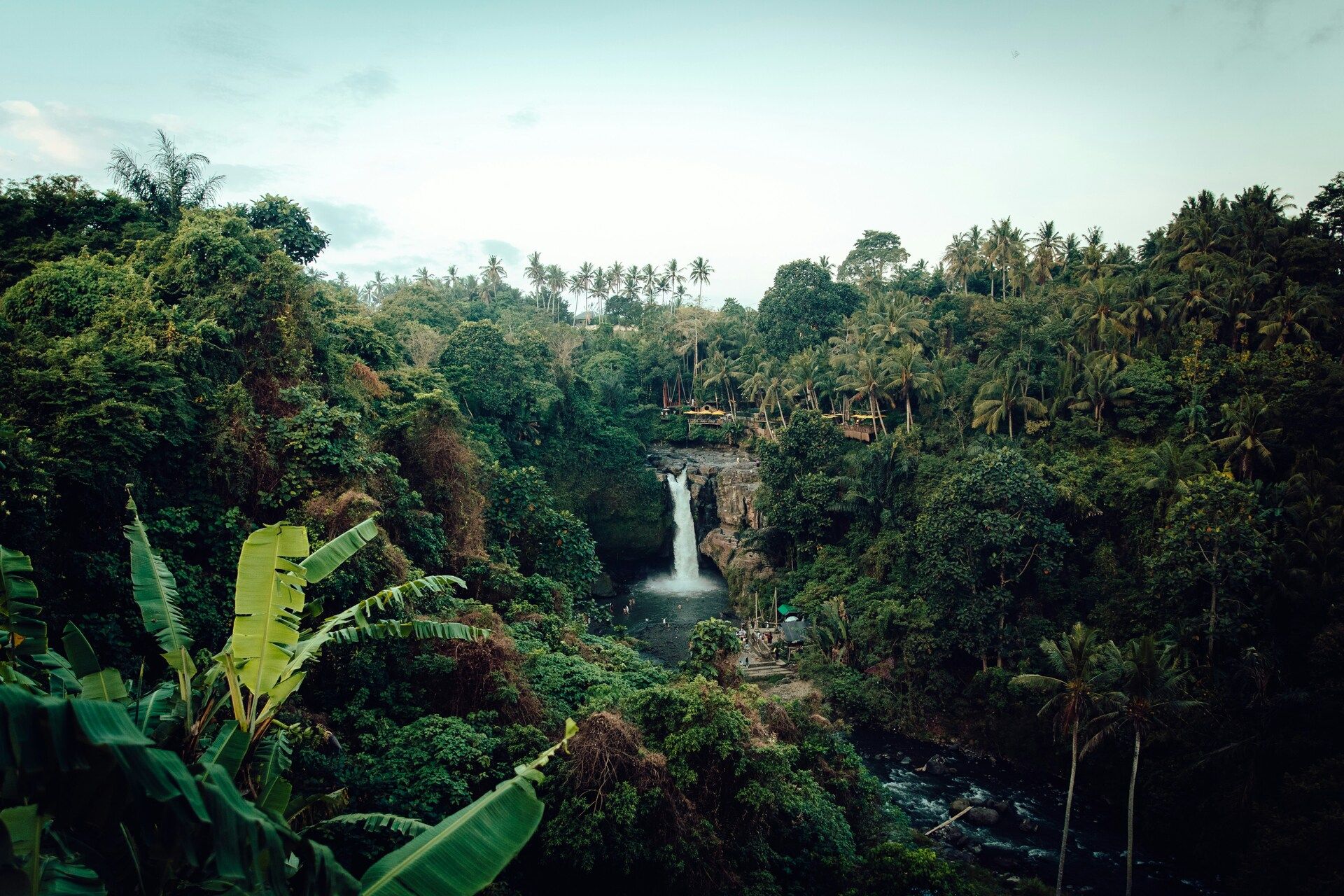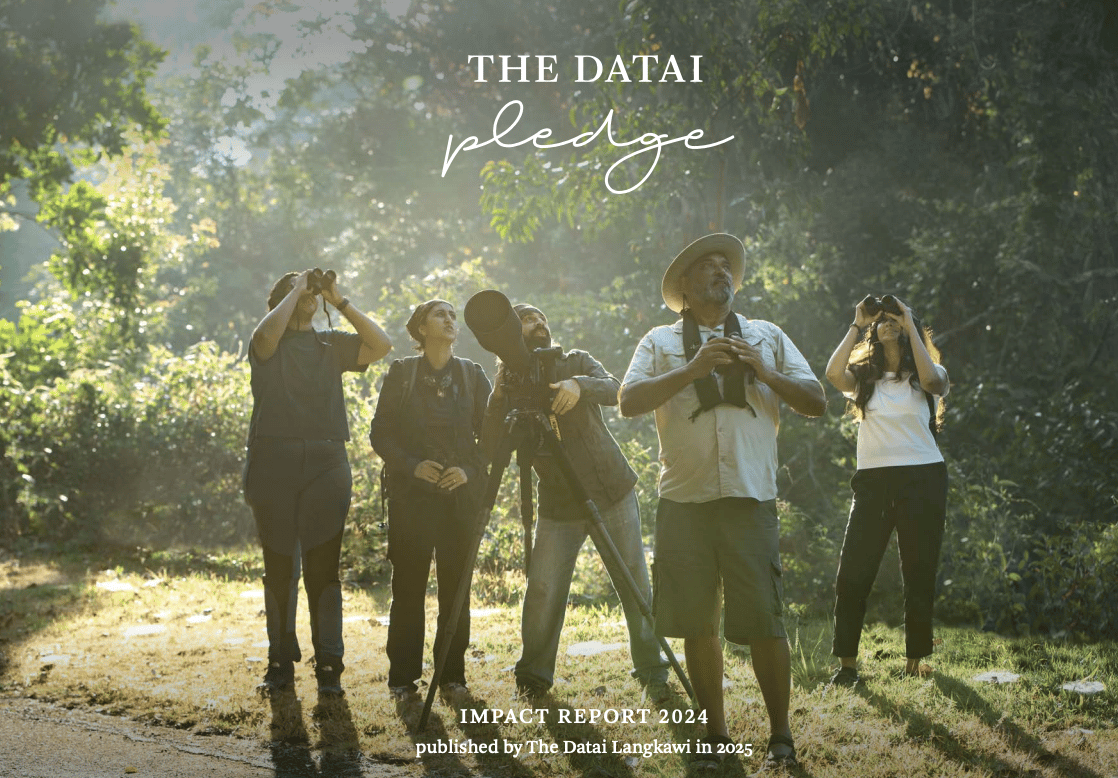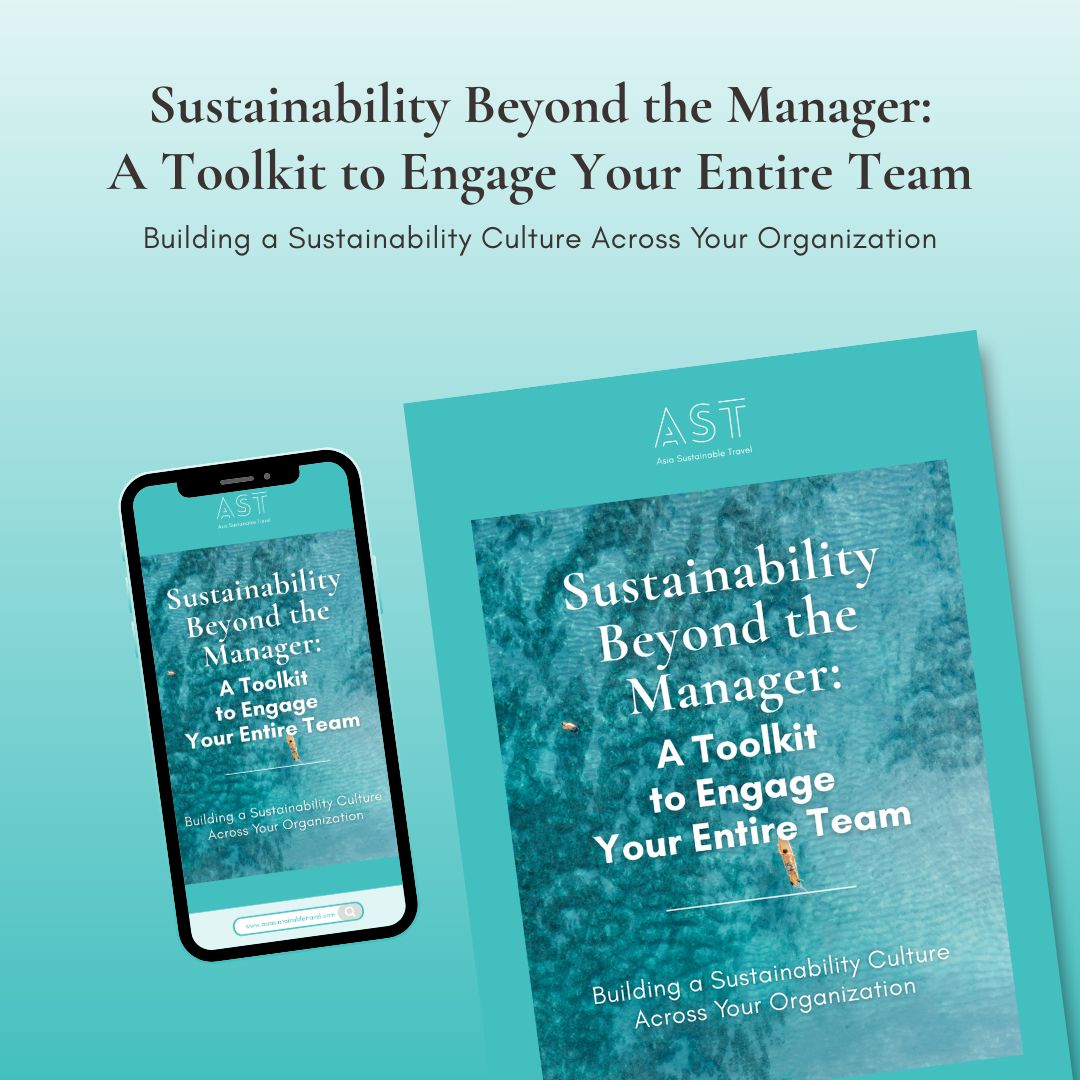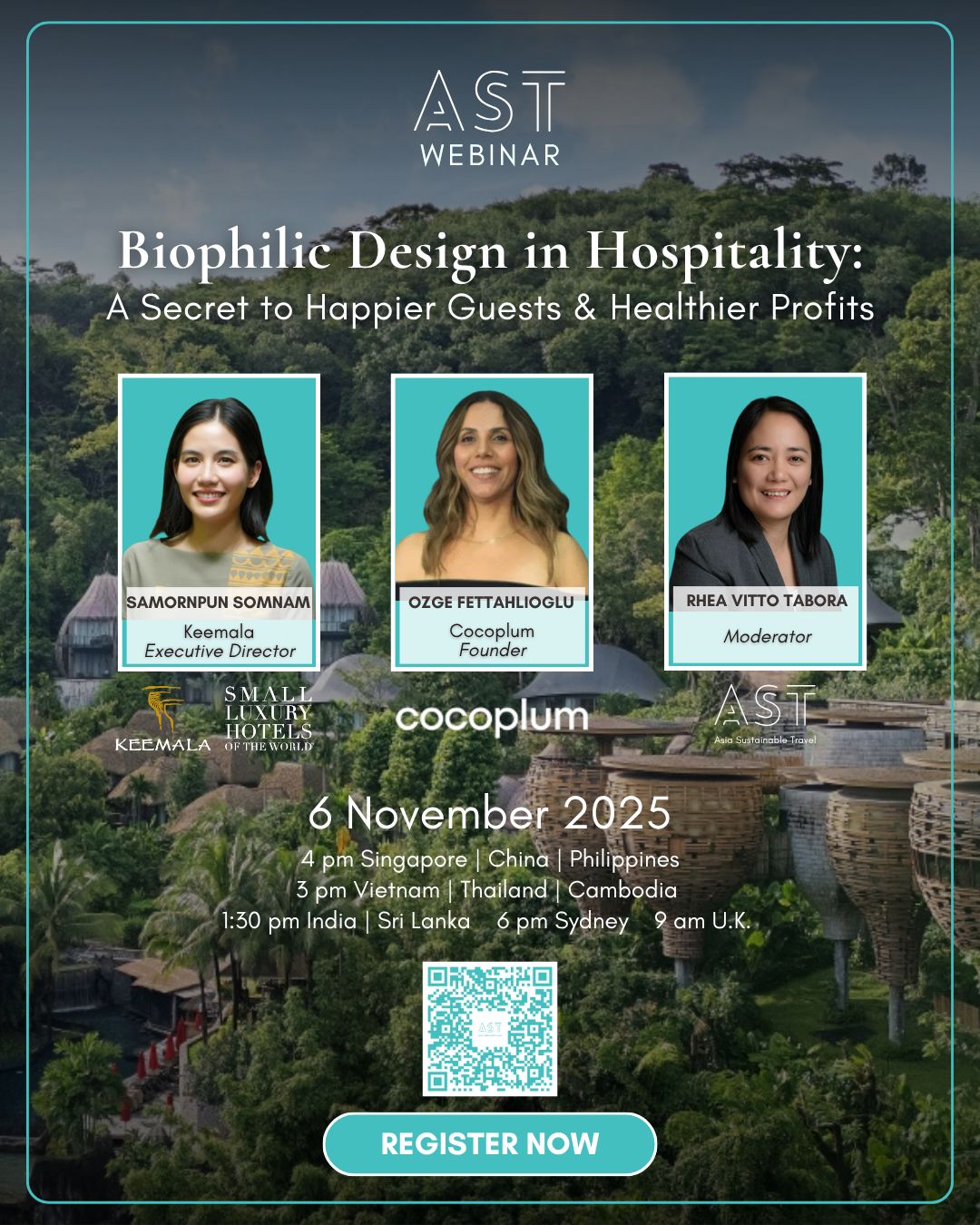- Asia Sustainable Travel
- Posts
- Why Does Sustainability Still Feel So Difficult in Asian Hospitality?
Why Does Sustainability Still Feel So Difficult in Asian Hospitality?
Dear AST friend,
We’re stepping into the final quarter with energy and purpose, with quite a few exciting things happening across the AST community.
Yesterday, we hosted the AST Forum for Next-Gen Leaders at the Far Eastern University in Manila — an inspiring day filled with meaningful discussions and exchanges of ideas.
Our Co-Founder Rhea Vitto Tabora will be in Singapore on October 13–14, for IMM Asia 2025. If you’d like to meet her while she’s in town, simply reply to this email. She’d love to catch up.
And if you’re in New Delhi, don’t miss the Global Wildlife Fair, happening on October 10–12 at the Constitution Club of India, New Delhi. You’ll find more details below.
Lastly, don’t forget to mark your calendar for November 6, 2025, when we host our next webinar: “Biophilic Design in Hospitality: A Secret to Happier Guests & Healthier Profits.” Reserve your spot via the link below. 👇🏽
If you like our content and want to support us, please share this newsletter with your friends to help us grow.
We plant a tree to welcome every new subscriber through our partnership with OneSeed.

Why Does Sustainability Still Feel So Difficult in Asian Hospitality? It Shouldn’t.
Sustainability has become the top achievement symbol in Asia’s hospitality industry. From boutique retreats to global chains, every brand now wants to speak the language of circularity, carbon neutrality, and local sourcing.
However, beneath the glossy websites and bamboo straws lies a persistent paradox: for most hotels, embedding sustainability still feels complex, costly, and out of reach.
It isn’t a question of not knowing the challenge or the opportunity.
Hoteliers and tourism professionals know that today’s travelers, especially Gen Z and Millennials, are willing to pay a premium for brands that reflect their values.
But translating that awareness into measurable, profitable change requires three things: capital, credibility, and capability.
Reuters reports that Asia’s tourism rebound has reignited environmental pressures from Phuket to Kyoto.
The Straits Times warns that without new financing models, Southeast Asia’s tourism economies could buckle under climate adaptation costs.
And according to a recent EU report, investors are now tying valuations to verified ESG performance.
These are not abstract challenges. They are the operational bottlenecks that define who will lead — and who will lag — in the sustainability transition.
The Cost Conundrum: From Expense to Optimization
Many hotel operators still see sustainability as a cost center rather than a revenue driver.
As the South China Morning Post reported (paywall), many of Hong Kong’s luxury hotels continue to delay plastic phase-outs, fearing guest dissatisfaction during the transition to new amenities.
Across ASEAN, small and medium enterprises cite upfront costs for eco-certified products, postponing investments in solar power, wastewater systems, or electric vehicles.
The reasoning is familiar: the payback isn’t immediate.
But the economics have shifted. Rising energy prices, climate risks, and new carbon levies are coming down. If hotels think sustainability costs too much, inaction actually costs more.
Take textile waste, for example, one of the industry’s most overlooked cost sinks.
I Am Sustainable Studio transforms discarded hotel linens into reusable materials, saving 200,000 liters of water and 3.6 tons of CO₂ emissions per ton recycled. More than resource efficiency, it demonstrates how circularity can serve both the bottom line and the brand story.
Banyan Tree Krabi’s partnership with local artisans at Souvenirs from the Sea transforms washed-up plastic into upcycled tote bags for guests, creating employment while reducing ocean waste.
21 Carpenter Singapore, working with ipse ipsa ipsum, integrates agricultural byproducts into high-end interiors. It's proof that sustainability can elevate design instead of compromising it.
At JW Marriott Khao Lak Resort & Spa, kitchen waste becomes energy: 9,000 liters of used oil repurposed into biofuel, and coffee grounds compressed into briquettes in 2024.
Each of these cases challenges the outdated narrative that sustainability does not pay off. Circularity is key.

Photos by I Am Sustainable Studio
The Proof Problem: From Green Claims to Verified Credibility
In a marketplace flooded with sustainability claims, trust has become the rarest currency.
Reuters reports that almost 200 tourism certification labels now compete for attention, some even contradictory. It’s not hard to understand why travelers are confused and no longer trust vague “eco-friendly” claims, causing them not to act on their intention.
As the South China Morning Post reports, building trust with consumers on sustainability requires brands to be transparent with their journey.
But for most hotels, this could mean an arduous shift — from operating on intuition to open sharing stories about their business impacts as well as failures openly.
AST’s reporting shows that the most trusted hospitality brands share three practices: they quantify, contextualize, and communicate consistently.
Impact reporting, when treated as both a management and marketing tool, builds not only credibility but also commercial advantage.
The Datai Langkawi exemplifies this approach. Its The Datai Pledge Impact Report provides a transparent account on its progress, highlighting achievements in energy and waste reduction, biodiversity gains, and coral restoration. Guests can find out how their stay funds conservation.
At InterContinental Phuket Resort, digital boards display real-time sustainability metrics into storytelling at the lobby. The gestures of transparency convert environmental metrics.
Six Senses and Soneva, co-founded by Sonu and Eva Shivdasani, publish detailed impact reports recognized by the United Nations. They have transformed transparency into a hallmark of a conscious luxury brand.
These pioneers show that openness isn’t vulnerability, it’s a winning strategy.
As “greenhushing” spreads across brands fearful of scrutiny, those who report honestly are building lasting trust.
→ Check out AST founder’s story and impact report templates to help you get started on telling your story in a way that resonates with your audience.
The Capability Gap: From Policy to Practice
Capital and commitment mean little without execution.
Across Asia, the organizational capability gap — the distance between intent and implementation — remains one of the most persistent barriers to achieving sustainability.
Too many sustainability initiatives fail because they are confined to a department instead of embedded into the DNA of the organization. For example, marketing may promote locally-sourced and zero-waste restaurants, while the kitchen team still wastes food.
No matter how well the sustainability managers perform individually, without cross-department alignment, the impact will be short-lived and fragmented.
Discovery Coron in the Philippines demonstrates how to turn that fragmentation into cohesion. Its EcoConserve Program, launched in 2016, began with four committees and now spans every department. Employees join teams based on personal interest:
GARMA (Garbage Management): Eliminates single-use plastics, turns bottles into refillables, and upcycles tires into hiking trail reinforcements.
Sea Guardians: Manage coral planting, biodiversity monitoring, and reef protection with local partners.
Green Thumb: Runs the Taranuman organic farm, turning kitchen waste into compost and fresh produce for farm-to-table dining.
FEW Champs (Fuel, Energy, and Water): Tracks resource use through real-time dashboards, empowering staff to act on inefficiencies immediately.
Its success stemmed from treating sustainability not as a department, but as a shared culture.
At PARKROYAL COLLECTION Marina Bay, the sustainability culture starts with onboarding. New hires undergo sustainability orientation in their first 60 days, learning how their roles connect to larger environmental goals. Gamified “sustainability races” engage teams, while cultural events reinforce pride and ownership.
Leadership matters too. Viceroy Bali institutionalizes the sustainability culture via dedicated departmental champions, turning philosophy into operating culture.
Meanwhile, Dusit International’s Tree of Life program sets a new benchmark. Its 31-criteria framework guides environmental, social, and governance practices across hotels, food enterprises, and educational ventures. Each property progresses through four tiers — from baseline compliance to Level 4 excellence — verified through both internal audits and external assessments.
Together, these examples underscore a shared truth: sustainability competency is just as important as service competency.
Sustainable hospitality thrives not on slogans, but on a shared culture and the empowerment of every employee.
The companies that embed sustainability into every process and job function will be the ones that endure in today’s ever-evolving world.

Are you in New Delhi? Come to the Global Wildlife Fair
From October 10 to 12, 2025, our friends at Asian Ecotourism Network (AEN) will be at the inaugural Global Wildlife Fair (GWF), a global gathering of voices from across conservation, sustainable travel, green enterprise, civil society, and youth networks.
Whether you're a tour operator, NGO, gear company, conservationist, eco-artist, or community leader — GWF 2025 is your opportunity to collaborate, showcase, and co-create.
🎯 Supported by: Wildlife Trust of India & Asian Ecotourism Network
📍 Venue: New Delhi, India
🌐 Info & contact: [email protected] | www.globalwildlifefair.com
Join us at the next AST Webinar
It’s free to attend the live webinar. Please register to secure your spot.
If you’re an AST Trailblazer, you’ll have access to the webinar recording along with the ready-to-use toolkit afterwards.

This newsletter may contain affiliate links. If you click on one and make a purchase, we may earn a commission at no additional cost to you. Our recommendations are based on thorough research and personal experience, and we only promote products and services we genuinely believe in. Thank you for supporting our work.












